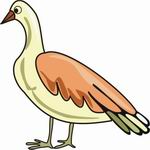- Weight: males 41-46 oz; females 31-34 oz.
- Length: 30"-36".
- Flight speed: 38-48 mph.
- Habitat: grasslands, wetlands, and brushy areas interspersed with
agriculture.
- Foods: waste grains and weed seeds.
- Life expectancy: 70% annual mortality rate; 2-3% of population lives
to age 3.
- Mating: polygamous; one male breeds many females.
- Nesting period: peak April-June, range March-August.
- Nests: usually shallow, scratched-out depression in the ground lined
with grass or leaves.
- Clutch size: 11 eggs for first nests.
- Eggs: olive-brown; ovate (17/8" x 13/8").
- Incubation: 23 days.
- Young: precoccial; leave nest immediately; can make short flights
at 12-14 days.
- Number broods per year: 1; will renest up to 4 times.
- Nest success: ave. 43%.
- Fledge: hen and brood separate 8-11 weeks post-hatch.
- Recruitment: ave. 3.7 young/hen.
- Migration: none; year-round resident.
- Pheasants are long-tailed, seed-eating, chicken-like gamebirds.
- Male pheasants, "roosters or cocks" are brilliantly colored
with a combination of russet, copper, brown, gray and black on the body,
iridescent dark green on the neck, and bright red wattles on the head.
- A white neck ring is present on most males.
- Females or "hens" are light brown with black flecking on
each feather.
- Newly hatched chicks are covered with soft buff-colored down with
dark markings on the head and back, and weigh about a half an ounce.
- Juveniles of both sexes, up to 10 weeks old, resemble females in
color, and by 16 weeks of age, they are almost indistinguishable from
adults.
- Adult males weigh about 2 ¾ pounds and females about 2 pounds.
- Cock pheasants have spurs on their legs that increase in length, as
they grow older
- The spurs on juvenile males are generally less than 3/8 of an inch
in length; spurs on old males may be almost an inch long.
|


